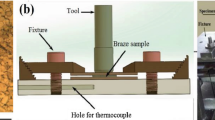Abstract
In the boring process, tool vibration is an important issue that can be suppressed using magnetorheological fluid damper with the varying magnetic field. But the rise in temperature and sedimentation of iron particles in a magnetorheological fluid is a challenging factor. In this study, magnetorheological fluid is impregnated with nanoparticles as additives to enhance viscosity and reduce temperature. Aluminum oxide, titanium oxide and zirconium dioxide nanoparticles of 0.1, 0.2 & 0.3% concentration by weight were measured. Cutting experiments were performed to investigate the reduction in temperature and increase in viscosity of nanoparticles impregnated in magnetorheological fluid and thus increases the tribological properties of the boring process.







Similar content being viewed by others
References
Avinash B, Shyam Sundar S, Gangadharan KV (2014) Experimental study of damping characteristics of air, silicon oil, magneto rheological fluid on twin tube damper. Proc Mat Sci 5:2258–2262. https://doi.org/10.1016/j.mspro.2014.07.443
Biju CV, Shunmugam MS (2018) Development of a boring bar with magneto rheological fluid damping and assessment of its dynamic characteristics. J Vib and Con 24(14):3094–3106. https://doi.org/10.1177/1077546317700715
Carlson J D and Sproston J L (2006) Controllable fluids in 2000— Status of ER and MR fluid technology. In 7th International Conference on New Actuator, Bermen, 126 -130.
Choi J, Han S, Nam KT, Seo Y (2020) Hierarchically structured Fe3O4 nanoparticles for high-performance magnetorheological fluids with long-term stability. ACS App Nano Mat 3:10931–10940. https://doi.org/10.1021/acsanm.0c02187
El-Hadad A A, Barranco V, Samaniego A, I Llorente, F R. García-Galván, A Jiménez-Morales, J C. Galván and S Feliu Jr (2014) Influence of substrate composition on corrosion protection of sol–gel thin films on magnesium alloys in 0.6 M NaCl aqueous solution. Prog Organic Coatings, 77(11), 1642–1652. https://doi.org/10.1016/j.porgcoat.2014.05.026
Emami M, Hasan Nasab V (2021) Design and simulation of magneto-rheological (MR) fluid damper and experimental study of its effect on tool vibrations in cut-off operation. Ira J of Manuf Eng 7(12):24–36
Ginder JM, Davis LC, Elie LD (1996) Rheology of magnetorheological fluids models and measurements. Int J of Mod Phy B 10:3293–3303. https://doi.org/10.1142/S0217979296001744
Gopinath, B., Sathishkumar, G. K., Karthik, P., Charles, M. M., Ashok, K. G., Ibrahim, M., & Akheel, M. M. (2021). A systematic study of the impact of additives on structural and mechanical properties of magnetorheological fluids. Ma. Toda Pro., 37, 1721–1728.https://doi.org/10.1016/j.matpr.2020.07.246
Hart LD (1990) Alumina Chemicals: Science and Technology Handbook. American Ceramic Society, Columbus, Ohio, USA
Lawrance G, Sam Paul P, Varadarajan AS, Paul Praveen A, Ajay VX (2017) Attenuation of vibration in boring tool using spring controlled impact damper. Int J Interact Des Manuf 11(4):903–915. https://doi.org/10.1007/s12008-015-0292-1
Lawrance G, Sam Paul P, Ajay Vasanth X, Varadarajan AS, Daniel E (2019) Influence of magnetorheological elastomer on tool vibration and cutting performance during boring of hardened AISI4340 steel. J Mech Sci Technol 33(4):1555–1561. https://doi.org/10.1007/s12206-019-0307-0
Mishra A (2014) Analysis of titanium dioxide and its application in industry. Int J Mech Eng Robot Res 3(3):561–565
Mohan E, Natarajan U (2016) Experimental investigation on boring tool vibration control using MR fluid damper. J of Adv Manuf Sys 15(1):13–25. https://doi.org/10.1142/S0219686716500025
Park B J, You J L, Choi H J, Park S Y, Lee B Y (2009) Synthesis and magnetorheological characterization of magnetite nanoparticle and poly(vinyl butyral) composite IEEE Trans Mag, 45(6), 2460–2463. https://doi.org/10.1109/TMAG.2009.2018612
Prasanna Kumar G, Seetharamaiah N, Durga Prasad BL (2017) Improvement of surface quality using Magneto-Rheological Fluid (MRF) boring bar. Int J Dyn Fluids 13(1):29–46
Rabinow J (1948) The magnetic fluid clutch. Electr Eng 67(12):1167–1167. https://doi.org/10.1109/EE.1948.6444497
Sam Paul P, Varadarajan AS, Mohanasundaram S (2015a) Effect of magnetorheological fluid on tool wear during hard turning with minimal fluid application. Archiv Civ Mech Eng 15(1):124–132. https://doi.org/10.1016/j.acme.2014.03.007
Sam Paul P, Agnelo Iasanth J, Ajay Vasanth X, Varadarajan AS (2015b) Effect of nanoparticles on the performance of magnetorheological fluid damper during hard turning process. Friction 3(4):333–343. https://doi.org/10.1007/s40544-015-0096-0
Sam Paul P, Varadarajan AS (2012) Effect of magneto rheological damper on tool vibration during hard turning. Front Mech Eng 7(4):410–416. https://doi.org/10.1007/s11465-012-0341-4
Sam Paul P, Varadarajan AS, Ajay vasanth X, Lawrance G (2014) Effect of magnetic field on damping ability of magnetorheological damper during hard turning. Archiv Civ Mech Eng 14(3):433–444. https://doi.org/10.1016/j.acme.2013.11.001
Schwartz M (2002) Encyclopedia of smart materials. John Wiley & Sons, New York
Song KH, Park BJ, Choi HJ (2009) Effect of magnetic nanoparticle additive on characteristics of magnetorheological fluid. IEEE Trans Mag 45(10):4045–4048. https://doi.org/10.1109/TMAG.2009.2025390
Yang G, Spencer BF Jr, Carlson JD, Sain MK (2002) Large-scale MR fluid dampers modeling and dynamic performance considerations. Eng Struc 24(3):309–323. https://doi.org/10.1016/S0141-0296(01)00097-9
Zhu W, Dong X, Huang H, Qi M (2020) Enhanced magnetorheological effect and sedimentation stability of bimodal magnetorheological fluids doped with iron nanoparticles. J of Intel Mat Sys Struct. https://doi.org/10.1177/1045389X20924831
Acknowledgements
The authors would like to acknowledge Mr. Jones Robin, Mr. Devamanoharan, and Mr. Sivasankaran of Karunya Institute of Technology and Sciences, India for their support during experimentation.
Funding
No Funding.
Author information
Authors and Affiliations
Corresponding author
Ethics declarations
Conflict of Interest
The authors declare that there is no conflict of interest.
Additional information
Publisher's Note
Springer Nature remains neutral with regard to jurisdictional claims in published maps and institutional affiliations.
Rights and permissions
About this article
Cite this article
Lawrance, G., Paul, P.S., Vasanth, X.A. et al. Study of nanoparticles impregnated magnetorheological fluid on tribological properties during boring process. Int J Syst Assur Eng Manag 13, 1955–1963 (2022). https://doi.org/10.1007/s13198-021-01610-0
Received:
Revised:
Accepted:
Published:
Issue Date:
DOI: https://doi.org/10.1007/s13198-021-01610-0




